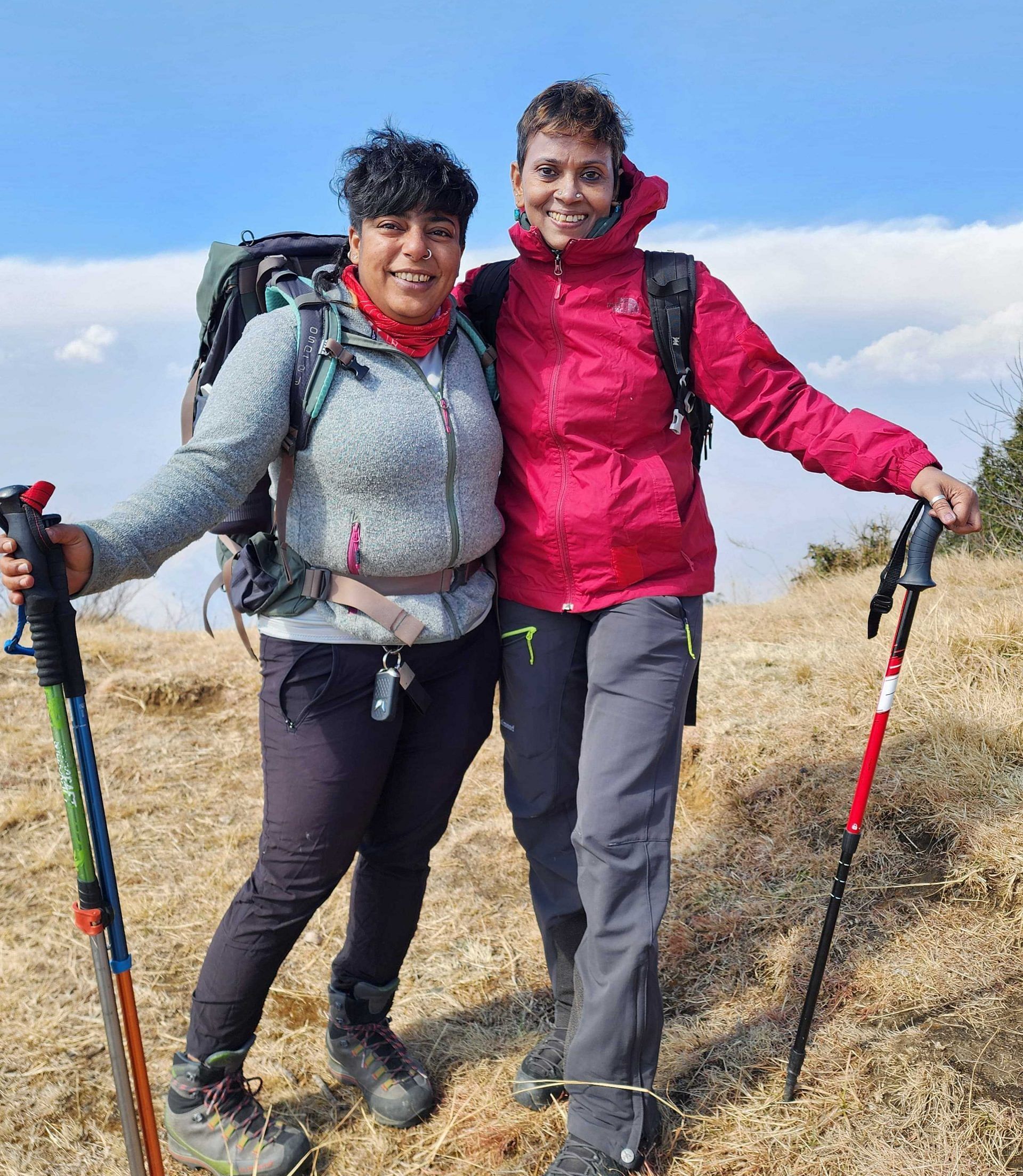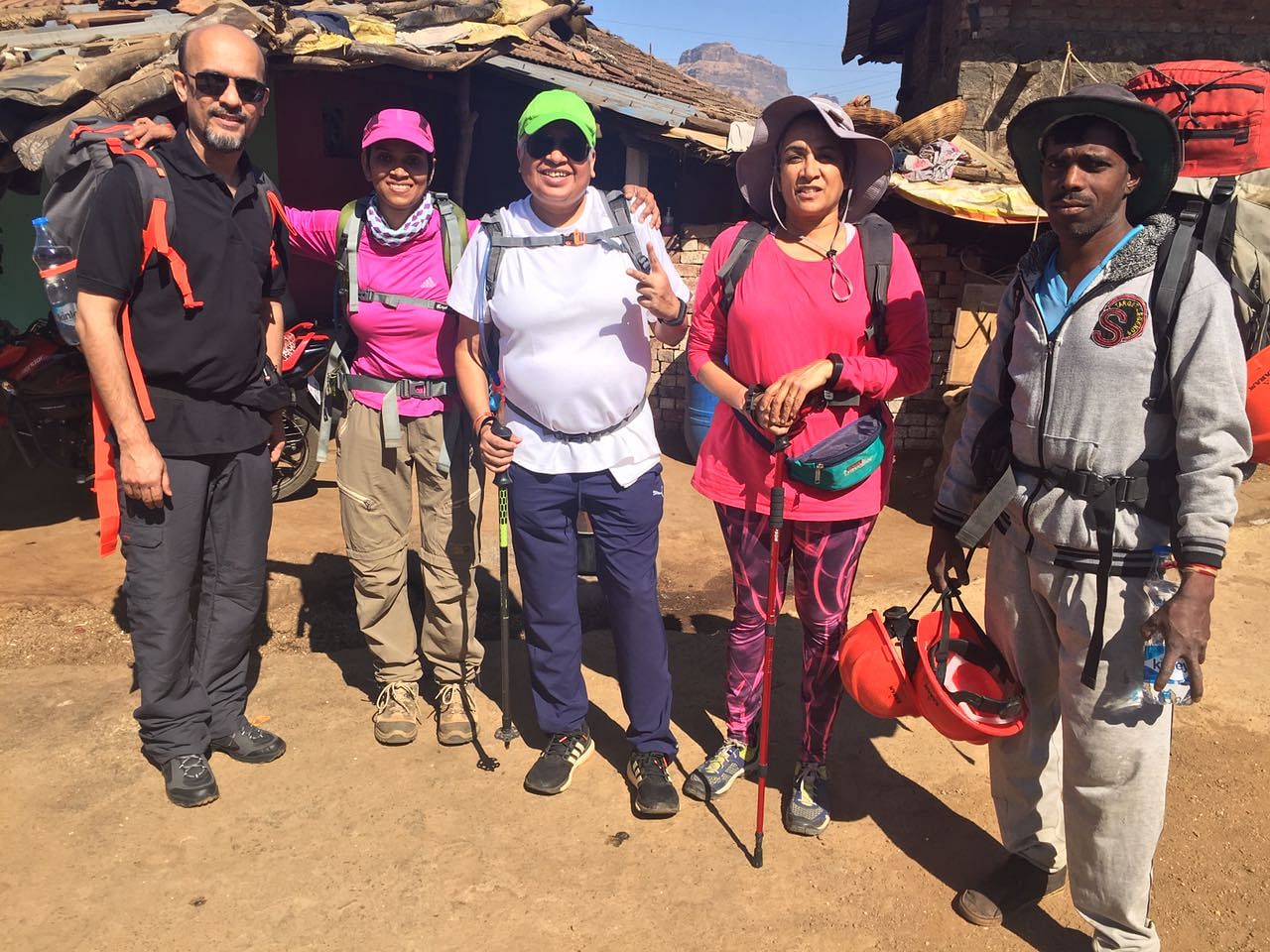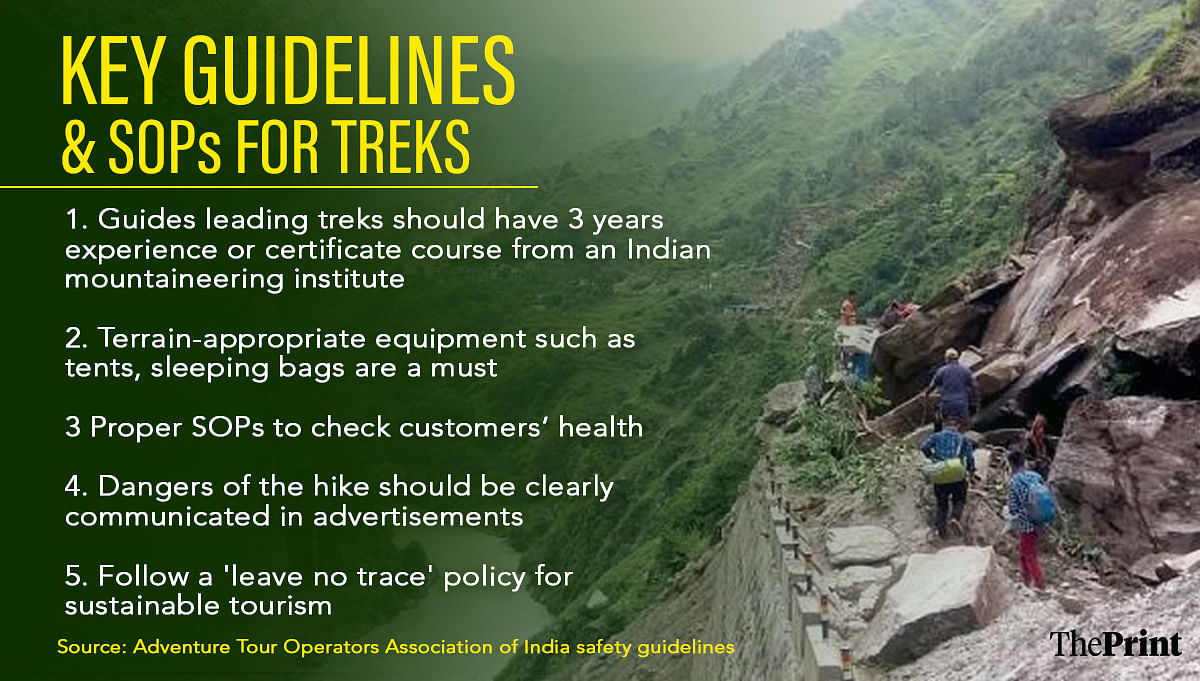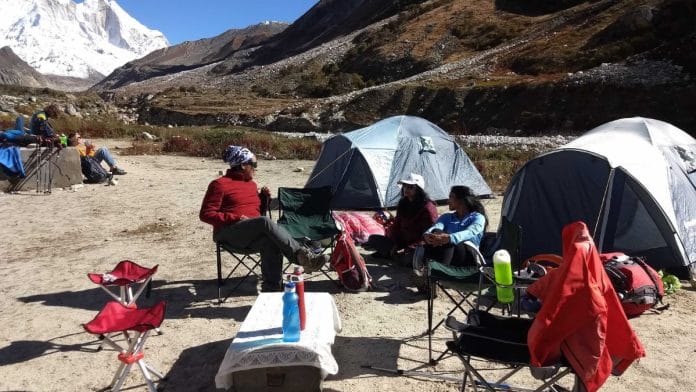New Delhi: Rajesh Singh ran down the mountain for 10 hours to get cellphone reception and make the SOS call. Twenty-two people were trapped at an altitude of 14,500 ft near Sahastra Taal in Uttarkashi. That was on 3 June. By the time rescue operations concluded, nine people had died.
The tragedy in Uttarakhand is a wake-up call. Droves of Indians are turning to the mountains to escape the teeming masses in their cities. And adventure sports companies are answering the call with cheap, all-inclusive packages to some of the most challenging treks in India. It’s resulted in a boom in fly-by-night operations that function outside the ambit of existing regulations.
A Nepali mountaineer’s viral 2019 photograph of a traffic jam of climbers leading to the Everest summit pushed the Nepal government to introduce rules and regulations. In India, it’s not just mountains and pilgrim sites but even hiking trails that are groaning under the weight of thrill seekers, guides, and adventure sports businesses. Human traffic jams along popular hiking trails like the Valley of Flowers in Uttarakhand or Kheerganga in Himachal Pradesh are the new normal—like trying to get to Bengaluru from the airport.
India’s newfound passion for heights is straining resources. It’s threatening the fragile ecosystem. Basic safety measures are pushed to the back burner. Government resources are stretched to the limit. And people are dying.
“Indians are willing to risk their lives for a cost-effective trip,” said Anusha Subramanian, founder and partner at Bohemian Adventures LLP. “Being experienced doesn’t mean you can take groups to the mountains. People who have done several high-altitude treks and aided climbs of high peaks are organising trips by hiring local agencies in the areas they are venturing into. However, these people are not mountain guides. Being a guide involves a whole lot,” Subramanian told ThePrint.
Established hiking and trekking companies like Bohemian Adventures now find themselves competing with communities on Instagram that are organising hikes.
“There is no government or regulatory oversight of the trekking companies either,” said Guneet Puri, a professional and certified mountaineer.

While the Indian Mountaineering Foundation, the apex national body for mountaineering and allied sports, grants licences and regulates mountaineering expeditions of India’s peaks, such rules don’t exist for trekking agencies. There are no government-issued directives that the companies have to adhere to.
“For higher peaks one needs permission to climb from the IMF, especially the ones which are in geopolitically sensitive zones. For example, if I want to climb Kamet, the highest climbable peak in India, then I would need IMF’s permission,” mountaineer Kuntal Joisher told ThePrint.
A set of guidelines was issued by the Adventure Tours Operators Association of India (ATOAI) in 2018, which was endorsed by then Minister of State (Tourism), KJ Alphons. But these guidelines are not legally binding.
Treks that go through Uttarakhand’s forest areas, though, require permission from the forest department.
Indians are willing to risk their lives for a cost-effective trip
– Anusha Subramanian, founder and partner at Bohemian Adventures LLP
The Uttarkashi administration has found evidence of negligence on the part of Himalayan View Trekking, the operator that conducted the ill-fated Malla-Silla-Kushkalyan-Sahastra taal hike. It has been ordered to stop commercial trekking until further notice.
“We try to encourage as many people to come on board with us, and help them formulate international best practice SOPs,” said Ajeet Bajaj, president of ATOAI, which has 700 registered adventure tour operators under its banner.
Also read: India’s new tourism boom is in the sky. Uttarakhand to Andamans, stargazing on the rise
No assistance at 14,500 ft
Once he reached Lamdal base, Rajesh Singh who works with Himalayan View Trekking as a guide, made the SOS call to the District Disaster Management Association at 4 pm. A blizzard had hit the area on the afternoon of 3 June.
“While trekking down, the group faced adverse weather conditions and there was a white-out event. People couldn’t see the direction where they were headed,” Jay Panwar of DDMA in Uttarkashi told ThePrint.
But rescue operations couldn’t be started immediately. At 4 pm, it was already too late to trek up the hill. The forest department was informed at 4:10 pm, according to officials at DDMA, and a team set up a base camp at Silla to start the trek for Sahastra Taal the next day.
“At 9 pm we got a call from the Indian Mountaineering Foundation who asked us to call the Army. We then informed the Air Force, which sent two Cheetah Helicopters, one Mi-17, and two civil aircraft. Rescue operations began at night itself,” Panwar added.
Two ground rescue teams of 10 forest guards rescued two trekkers at 5 pm on 4 June. By then, of the 22 people trapped, four had died. The trekkers had to sit alongside the dead bodies of their group members for 36 hours before they could be rescued by the State Disaster Response Team. Five died during the rescue operations. All 22 people had symptoms of hypothermia and altitude sickness.
Maninder Kohli, who is a member of the Indian Mountaineering Foundation and reviews such accidents and disasters, said one way to mitigate risk is having a good guide-to-trekker ratio.
“On some of these treks, the guide-to-trekker ratio isn’t healthy. The ideal guide-to-trekker ratio should be 1:3,” he said. Himalayan View Trekking had three guides for 22 people, according to a DDMA official.
“A group of 22 for a level two trek is also a large group,” Kohli added. He defined a level two trek as a trail between the range of 4,000-5,000 metres. “Anything above that is mountaineering.”
Subramanian and Puri also conduct ‘inclusive treks’ together. They curate trips for persons with disabilities as well as hikes for older people. Both mountaineers say the guide-to-trekker ratio with an older age group should be further improved to 1:2.
The average age of the group of trekkers on the Sahastra Taal hike was 49. Both the oldest and youngest—71-year-old Asha Sudhakar and 34-year-old Padmini Hegde—died in the incident.

The group was caught in an off-season snowstorm. The end of May to June is considered the perfect time to embark on the Sahastra Taal trek, with storms expected only in July.
But due to climate change, storms in the mountains are becoming unpredictable, more fierce, and erratic.
“On the day of the incident, they were returning from Sahastra Taal to the base camp. It was summit day, which meant movement of eight to nine hours, and they must have started early in the morning. I am determining if they knew of the bad weather conditions or not in advance,” Kohli said.
Due to geopolitical reasons and security issues, some states don’t allow trekkers to carry satellite phones with them, so SOS calls are delayed. In Uttarakhand, though, there are no such guidelines. But the cost of acquiring a satellite phone, more than Rs 1 lakh, deters cash-strapped agencies. It’s another reason why there are delays in rescue operations, multiple people associated with the trekking industry told ThePrint.
On some of these treks, the guide-to-trekker ratio isn’t healthy. The ideal guide-to-trekker ratio should be 1:3
– Maninder Kohli, member, Indian Mountaineering Foundation
A source in the DDMA, Uttarkashi, expressed frustration at trekking companies that don’t inform the local agencies about their whereabouts before starting on a trek.
“Had we known their plan, we could have given them the weather forecast we received in advance,” he said, requesting anonymity.
He also complained that the DDMA is overburdened, and under-compensated. An average worker at DDMA earns only Rs 10,000 a month; and in a place like Uttarkashi, they have to constantly manage disasters, from forest fires to floods.
“Workers aren’t compensated properly and they aren’t too motivated to keep their eyes and ears open all the time,” he said.
The police have registered an FIR against the trekking company under sections 304 A (causing death by negligence) and 336 (acting rashly to endanger life) of the Indian Penal Code. A police personnel, on the condition of anonymity, also claimed that the guides didn’t accompany the trekkers to the peak, but stopped at the advanced base. No prior health checkups were conducted either.
Kohli said every district has rescue teams, but for high-altitude rescue operations, the local administration relies on the Air Force. The District Magistrate has the authority to call on the armed forces for help. In addition to it, there is local help. “Local villagers have also formed rescue groups, and often act as first responders whenever an SOS call is made,” he said.
DDMA workers aren’t compensated properly and they aren’t too motivated to keep their eyes and ears open all the time
– DDMA source, Uttarkashi
SOS calls on hills are very frequent, but casualties aren’t, Panwar said. “I got a call yesterday from a German tourist who had injured his knee on the top of a mountain. We provided assistance immediately,” he added.
According to ATOAI guidelines, a trek tour operator should have a minimum of three years of experience assisting treks at a minimum height of 3,000 metres, or have certification from any of the four national mountaineering institutes of India, or they have to be accredited by IMF and should also have done a CPR training course.
“Tour guides that some of the big companies bring are not well trained. They’re local men or women who start trekking, or have done a basic course but have no experience. We usually train people who have done these courses to accompany as cooks on the trek so they can gain experience,” Subramanian said.

Kohli added that when trekkers from urban areas hire local tour guide operators, there is often a gap in the decision-making process in the mountains, which is crucial. “Decision-making involves aspects like determining who will do the final stretch to Sahastra Taal based on their health and fitness. It is dependent on a leader who is tasked with managing the group. In most situations the local team may have the understanding of the ground situation but are not in a position to assert themselves,” he said.
Tour guides that some of the big companies bring are not well trained. They’re local men or women who start trekking, or have done a basic course but have no experience
– Anusha Subramanian, founder and partner at Bohemian Adventures LLP
Also read: Tourists in Pench aren’t just looking for tigers–now, they’re looking up at the stars
A numbers game
A low guide-to-trekker ratio and inexperienced guides are some of the many cost-cutting measures tour operators take to offer budget operations.
“Many teams look at a trek with a budget. To achieve this they look at start-up organisations that are willing to manage the trips at a lower cost. In high altitude treks in the range of 4500-5000 metres it is imperative to be well resourced to the risk associated with the terrain and vagaries of weather,” Kohli said.
New consumers of thrill-seeking holidays are often unaware of these nuances. It took a 27-year-old lawyer from Noida years to identify reliable tour operators who prioritise safety over everything else.
She tries to go on at least two trekking trips to the Himalayas every year and a week-long trek every two years.
“Once I went on a budget trek advertised on Instagram…and I won’t do it again, it was too hectic, and the guides didn’t seem well experienced. Now that I have been trekking for so long, I know the right people to go with. But those who don’t, and just want to explore, might not have the best experience,” she said.
At high altitudes, where anything can happen, you can never be too safe. The lack of laws and rules only adds to the uncertainty.
Kohli, who is also the founder of Juniper Outdoor Pursuits Centre, said that, while people cannot be trained before trekking, it is important to determine their health and fitness level before recommending a trek to them.
It doesn’t help that potential clients try to bargain with operators for the ‘best rate’.
“When costs are cut, then your safety is also compromised. So many times people bargain with us and we have to decline taking them on that trip, because we need to ensure everything is taken care of, that our local operators are good, trained and well compensated,” Subramanian added. For a typical trek to Sahastra Taal, her company charges between Rs 80,000 and Rs 90,000 per person.

The trekking industry has boomed in the last 10 years. Itineraries are available online and people only need to show up at a bus stand with trekking shoes for the adventure. But environmental damage can go undocumented—until it’s too late. Trekkers often play loud music on speakers while trekking in forest areas, and leave waste behind, in some ways altering the ecology of the place. The volume of people going to popular trails has overburdened the mountains. ATOAI advocates for a ‘leave no trace’ policy.
On the other hand, this boom has given alternate sources of income to the local Pahari men and women. The key is to find a balance between ecology, safety and commercial activity, say industry experts.
So many times people bargain with us and we have to decline taking them on that trip, because we need to ensure everything is taken care of
– Anusha Subramanian, founder and partner at Bohemian Adventures LLP
But mountaineer Puri also offers a different perspective.
“Adventure tourism in India is very nascent, first taken up by the armed and paramilitary forces. And then it really started in the 60s… compare it with France where adventure sport can be traced back to the 1800s,” she said, “people just see a trail online and want to go there, but India has 73 per cent of the Himalayas. There’s enough space to accommodate everyone if we don’t concentrate only on some trails.”
Trails in India, she said, have been developed over 100 or so years. Some are older than that, used by Indian shepherds to get to the meadows, and later popularised by the British.
“Today, anyone can form a company, but more or less people associated with mountaineering are in the trekking industry. Young men from Himachal and Uttarakhand have also started companies,” Kohli added.
Trekking clubs and companies can apply for membership in the Indian Mountaineering Foundation, but it is not mandatory. They can also register with the state or central tourism departments, but with the advent of trekking communities on Instagram, but some clubs may not be following this either.
Mountaineer Anurag Malloo, who had a near-death experience last year on Mount Annapurna in Nepal called for stricter regulation in trekking as well as mountaineering. “I met my accident because the rope I clung on to shouldn’t have been there in the first place. We need greater security measures in place,” he said.
For the Noida lawyer, the mountains offer a measure of peace and solace. She hates the idea of going to a mainstream hill station.
“You find the same crowd there. Same Noida-Delhi people trying to get drunk in a different place. That’s not travelling for me, I seek something different,” she said.
(Edited by Theres Sudeep)







its very strange a lengthy article has been written without understanding the exact situation in which the whole accident had happened !! it requires two hands to clap !
i agree the agency “Himalayan View” was at fault but i blame squarely the so called experienced Karnataka Mountaineering Association ( KMA) who USED to organise mountaineering Expedition successfully in the past,but not the present set up!! when there are experienced and proven agencies in Organising difficult treks in that area available (Uttarkashi)and known to these office bearers of KMA,the reason,going for an inexperienced agency like above quoted one can only be one- just greed for money.!! No one knows how much money eas collected from the participants ? The so called experienced organisers ( read the present Office bearers of KMA) has no real experience to lead a not so difficult trek of Sahasra Tal as i am sure they would have taken the help of more guides but money making here is the prime agenda. Well its an organised game practiced by a few office bearers of KMA , for long time, but this time at Sahsara Tal, they did not realise that you cant play with nature every time. So the Blame is entirely on KMA who by their greed has made irreparable damage to Nine Families by nine deaths..!!! Only a judicial enquiry by Karnataka Govt will reveal all !! No amount of regulation can stop, when there is corruption at high level.. When so many old people present in that group any proper medical test was conducted ? Experience is one thing, and current physical fitness is another thing ? Pre monsoon conditions in mountains of Uttarakhand has started when they stared their trek and going for a difficult trek with a large group of 22 is sure shot recipe for disaster, which exactly happened !!